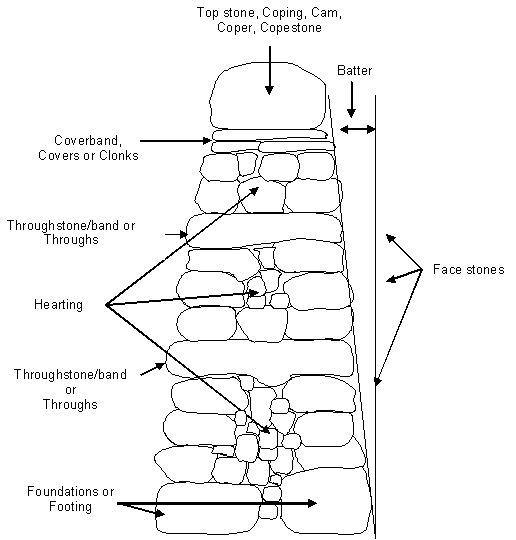The
following covers the main points of interest of dry stone walls that are
found in and around various climbing areas of the U.K.
www.mountaininstruction.co.uk
- Peak - Course Gritstone (Millstone grit)
- Fine sandstone grains deposited by great rivers from the east approx. 315 million years ago
- A regular pattern of coursing (like looking at a stair case/steps - side on) often due to thin Bedding Plains
- Easily shaped with a walling hammer
- Colour often due to iron staining
- Peak - Carboniferous Limestone
- Formed from ancient coral reefs deposited in tropical seas (approx. 330 million years ago)
- Contains numerous fossils
- When quarried, stone fractures along irregular lines and produces walls with a random style of coursing
- Lakes - Glacial erratic granite boulders (e.g. Ennerdale, Eskdale)
- Rounded due to the grinding action of glaciers, transportation in rivers and weathering
- Often a double wall of stones are used at the base, although due to their size single stones can be used higher
- Sometimes these walls can increase in height and width dramatically as stones have been cleared from fields (e.g. Duddon and Wasdale)
- Lakes - Cumbrian Slate Wall (e.g. Coniston and Ambleside)
- True slate (in geological terms). Comprised of fine mudstone compressed under immense pressure 430 million years ago
- Also known as flagstones
- Often set vertically and interweaved to provide strength
- Sometimes narrow slates are held together, like wooden fence posts, by wire, iron rods or special clips
- Lakes - Cumbrian Green Slate (e.g. Langdale and Coniston)
- Formed from ejected ash and rock (from large volcanoes approx. 470 million years ago), then compressed and heated into its current state
- Can be split along rough planes
- Copestones known as Cams and slope downhill to prevent slipping
- Cams overhang slightly to deter sheep
- Has many through stones
- Crimson colour from iron oxide
- Green colour from complicated alumino-silica minerals
- Scotland - Highland Single Boulder Dyke
- Often (but not exclusively) used in the Highlands with huge granite or crystalline quartzite boulders cleared from fields
- These course textured stones do not slip like smoother stone
- Can be just one stone in width due to huge boulders and no small stones available
- Daylight can be seen through it to deter sheep from trying to climb it!
- Each rock has at least three points of contact for stability
-
North Wales - Snowdonia has a complex geology and many of the oldest rocks in Wales. For example there is Carboniferous Limestone, Slates, Volcanic Rock, Schists Gneisses and Granite. This wide variety of rock is reflected in the diversity of wall constructions used in North Wales. All of the above styles (and variations of) can be seen. For example the surrounding areas of Llanberis and Nant Ffrancon show a variety of hybrids.
- Skye - Basalt Dyke (e.g. Isle of Skye)
- Rock formed from cooled lava flows some 63 million years ago
- Coping stones, rubble or turf can be used along the top
- Massive boulders are used at the base and can make up 75% of the height
- Basalt is black when first broken but weathers a dull grey
The history of dry stone walling
- Neolithic village of Skara Brae on the Orkney Isles built around 3000BC using D.S.W. techniques.
- D.S.W. justified in Old Testament - Ezekiel Chapter xiii, verses 10 and 11
- Nomadic pastoral and hunting gave way to settled farming and the ‘Celtic’ field system of small stone circles and irregular ditches and walls surrounding. Clearance cairns a feature. Used through Romano-British period in S.W. Moors, Lake District and Pennines
- Middle Ages meant ‘open field system’ of three sections, Wet lands, Common fields and Common Pasture
- 14th and 15th > 18th centuries householders legally permitted to enclose small ‘crofts’ or private holdings
- In 17th and 18th century British population growing & putting pressure on open field system
- 1780’s – Large landowners engineered private Enclosure Acts of Parliament which removed small farmers common rights of pasture. (1710 in Scotland). D.S.W. standards established, creating small rectangular plots. Built by hired surveyors and professional gangs, paid only by large landowners
- In Wales farmstead walls built by tenants whilst long mountain walls by landlords
- Most Lakeland walls created after 1801 Act
- Mining in 19th & 20th century continued D.S.W
- Road widening in 20th continued D.S.W.
- Numbers of wallers very small mid 20th century. Interest in conservation techniques now means numbers increasing

References: Edward Kinnear, Dry Stone Walling; BTCV, Col. F Rainsford-Hannay; Faber & Faber www.mountaininstruction.co.uk